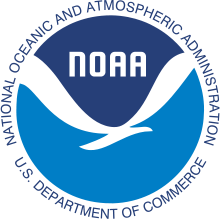Office of Oceanic and Atmospheric Research

National Oceanic and Atmospheric Administration seal
|
|
| Agency overview | |
|---|---|
| Formed | 1841 |
| Headquarters | Montgomery, Maryland, U.S. |
| Motto | OAR's Vision is to deliver NOAA’s future. OAR's Mission is to conduct research to understand and predict the Earth’s oceans, weather and climate, to advance NOAA science, service and stewardship and transition the results so they are useful to society. |
| Agency executives |
|
| Website | research |
Oceanic and Atmospheric Research (OAR) is a division of the National Oceanic and Atmospheric Administration (NOAA). OAR is also referred to as NOAA Research.
NOAA Research is the research and development arm of NOAA and is the driving force behind NOAA environmental products and services aimed at protecting life and property and promoting sustainable economic growth. Research, conducted by programs within NOAA and through collaborations outside NOAA, focuses on enhancing the understanding of environmental phenomena such as tornadoes, hurricanes, climate variability, changes in the ozone layer, El Niño/La Niña events, fisheries productivity, ocean currents, deep sea thermal vents, and coastal ecosystem health.
The origins of NOAA Research date back more than 200 years with the creation of the Survey of the Coast in 1807 by Thomas Jefferson. The Coast Survey, which became the U.S. Lake Survey office in 1841, was developed to undertake "a hydrographic survey of northwestern [Great] lakes." Research executed by the scientists of this group was innovative and holistic: the first current meters were developed to understand water flow rates, and forecasting techniques were greatly enhanced to predict water levels and the relationship to lakefront property. The same traits of world class, long-term research continue to define NOAA Research today.
The science and technology that NOAA Research produces is not only relevant to society, it anticipates and responds to partners’ needs to demonstrates the value of technologies so that partners can deploy them into their applications. OAR works with end-users to integrate mature technologies (and associated expertise) into larger systems, either in NOAA operations or partner applications, via testbeds, patents, etc.
NOAA Research is an open research network consisting of seven federal research laboratories, six program offices, sixteen Cooperative Institutes (which are non-federal, non-profit research institutions in 5-10 year collaborative partnerships with NOAA), and 33 university based Sea Grant programs. OAR also relies on work performed at numerous public, private, and academic institutions. Through its laboratories, programs, and external partners, OAR seeks to balance the activities that benefit from the long-term, dedicated capabilities of federal facilities with those that require the diverse expertise of our university partners.
...
Wikipedia
